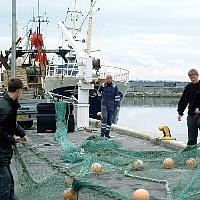(BRUSSELS) – The EU Council gave its final green light Monday to a revised fisheries control system, with a view to modernising the way fishing is controlled, and ensuring the prevention of overfishing in EU waters.
Around 70 per cent of the existing rules for controlling fishing vessels are updated by the newly adopted regulation, which will help ensure that EU vessels and other vessels fishing in EU waters follow the rules of the Common Fisheries Policy (CFP).
Main changes introduced include:
- vessel monitoring systems (VMS) and electronic recording of catches: to ensure compliance with the CFP, all fishing vessels will be tracked via a VMS and all catches will need to be recorded via electronic means; in the case of certain small-scale coastal fishing vessels under 9 metres in length, exemptions from the VMS requirement may be granted until 31 December 2029
- remote electronic monitoring tools will be used in the case of larger vessels to ensure that unwanted catches are not being discarded at sea in violation of the ‘landing obligation’, but instead brought to land
- recreational fisheries: recreational fishers catching specific species will need to record and report their catches via an electronic system; while, initially, a limited number of species will be covered, the number may increase based on scientific advice
- revision of the sanctioning system: a comprehensive list of serious infringements of CFP rules is established at EU level; member states must ensure that perpetrators are subject to effective, proportionate and dissuasive administrative sanctions; additionally, or as an alternative, criminal sanctions may be used
- improved digital traceability along the supply chain: it will be easier to trace fresh fishery and aquaculture products; in the case of processed products, this will be done following a Commission study on the available solutions and after a five-year transition period
To prevent overfishing, the new system introduces new rules on the margin of tolerance (or error) when estimating catches will also be introduced to prevent misreporting. The margin of tolerance represents the difference between the estimate of the fish caught and the actual result of the weighing. As a general rule, the margin of tolerance will be kept at 10% per species, as is the case currently. However, some exceptions will apply. For species not exceeding 100 kg, the margin will be 20% per species.
Derogations will apply for small pelagic fisheries, fisheries for industrial purposes and tropical tuna purse seine fisheries, in particular if catches are landed in ‘listed ports’, where special conditions for landing and weighing must be ensured.
Finally, certain larger vessels will be equipped with a device to measure engine power, to ensure that their fishing capacity remains within the limits set out in the CFP.
For imported products, a digital system (known as ‘CATCH’) will be introduced in the context of the catch certification scheme for illegal, unreported and unregulated (IUU) fishing. The aim is to ensure that catch certificates and other related documents will be managed in a single, EU-wide digital environment, thus improving the ability of authorities to detect products stemming from IUU fishing. Non-EU countries will be able to produce and validate catch certificates directly in the CATCH digital environment. For fishery products imported into the EU, importers will also need to submit catch certificates via CATCH.
Commission proposal on fisheries control regulation
Council strikes deal on new rules to combat overfishing (press release, 31 May 2023)


